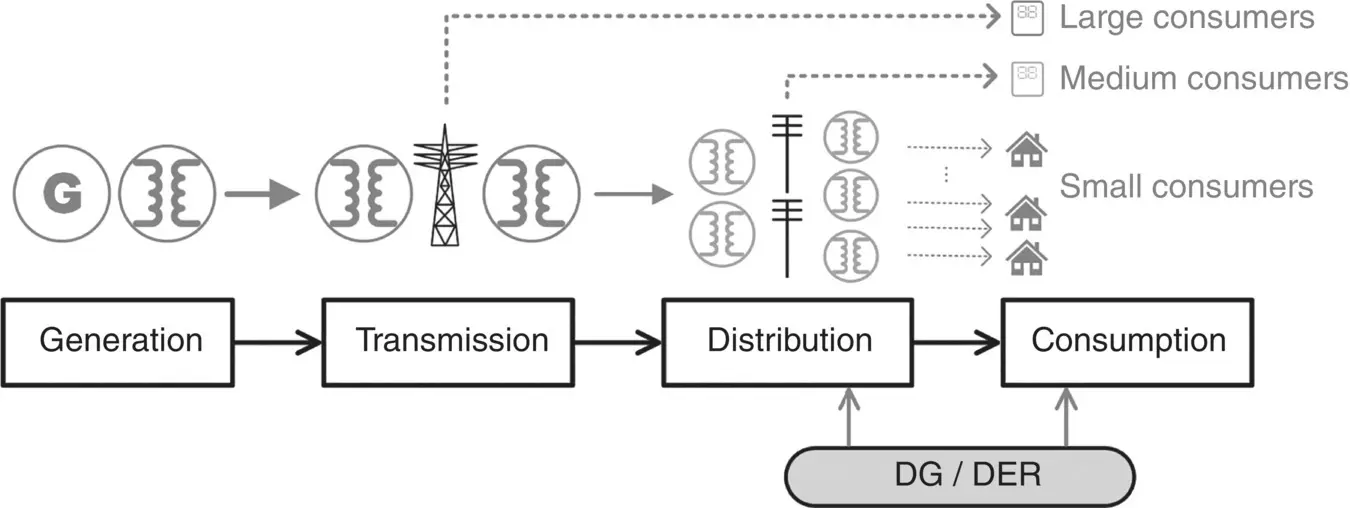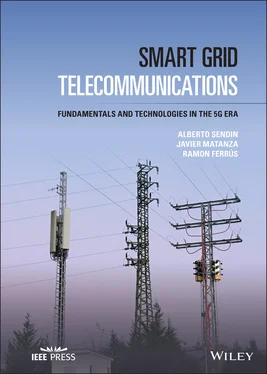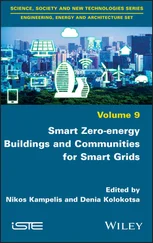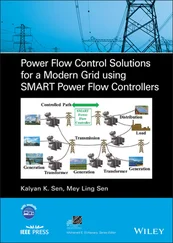Ramon Ferrús - Smart Grid Telecommunications
Здесь есть возможность читать онлайн «Ramon Ferrús - Smart Grid Telecommunications» — ознакомительный отрывок электронной книги совершенно бесплатно, а после прочтения отрывка купить полную версию. В некоторых случаях можно слушать аудио, скачать через торрент в формате fb2 и присутствует краткое содержание. Жанр: unrecognised, на английском языке. Описание произведения, (предисловие) а так же отзывы посетителей доступны на портале библиотеки ЛибКат.
- Название:Smart Grid Telecommunications
- Автор:
- Жанр:
- Год:неизвестен
- ISBN:нет данных
- Рейтинг книги:3 / 5. Голосов: 1
-
Избранное:Добавить в избранное
- Отзывы:
-
Ваша оценка:
- 60
- 1
- 2
- 3
- 4
- 5
Smart Grid Telecommunications: краткое содержание, описание и аннотация
Предлагаем к чтению аннотацию, описание, краткое содержание или предисловие (зависит от того, что написал сам автор книги «Smart Grid Telecommunications»). Если вы не нашли необходимую информацию о книге — напишите в комментариях, мы постараемся отыскать её.
Discover the foundations and main applications of telecommunications to smart grids Smart Grid Telecommunications,
Smart Grid Telecommunications
Smart Grid Telecommunications — читать онлайн ознакомительный отрывок
Ниже представлен текст книги, разбитый по страницам. Система сохранения места последней прочитанной страницы, позволяет с удобством читать онлайн бесплатно книгу «Smart Grid Telecommunications», без необходимости каждый раз заново искать на чём Вы остановились. Поставьте закладку, и сможете в любой момент перейти на страницу, на которой закончили чтение.
Интервал:
Закладка:
The International Electrotechnical Commission (IEC) has standardized three‐phase AC rms voltage levels internationally in IEC 60038:2009 within the following ranges:
Having a highest voltage for equipment exceeding 245 kV: 362 or 420 kV; 420 or 550 kV; 800 kV; 1100 or 1200 kV highest voltages.
Having a nominal voltage above 35 kV and not exceeding 230 kV: 66 (alternatively, 69) kV; 110 (alternatively, 115) kV or 132 (alternatively, 138) kV; 220 (alternatively, 230) kV nominal voltages.
Having a nominal voltage above 1 kV and not exceeding 35 kV: 11 (alternatively, 10) kV; 22 (alternatively, 20) kV; 33 (alternatively, 30) kV or 35 kV nominal voltages (there is a separate set of values specific for North American practice).
Having a nominal voltage between 100 and 1000 V inclusive: 230/400 V is standard for three‐phase, four‐wire systems (50 or 60 Hz) and also 120/208 V for 60 Hz. For three‐wire systems, 230 V between phases is standard for 50 Hz and 240 V for 60 Hz. For single‐phase three‐wire systems at 60 Hz, 120/240 V is standard. Practically, LV consumers within most 50 Hz regions will eventually be delivered 230 Vac, and 110 Vac in 60 Hz regions.
Thus, it can be said that while LV is clearly below 1 kV, the boundary between HV and MV is commonly placed at 35 kV.
1.2.2 The Grid
The “grid,” the power grid, the electric power system, or the electricity supply system, is defined by the IEC as “all installations and plant provided for the purpose of generating, transmitting and distributing electricity.”
The power grid is a hierarchical infrastructure comprising a large set of interconnected elements to provide electricity service to its end‐customers. The interconnected elements can be grouped in different building blocks, as shown in Figure 1.2. Traditional grids deliver the energy produced by the Generation systems to the Consumption Points, through Transmission and Distribution systems. Generation and consumption are matched in real time.
In a traditional conception of the power system, Generation is conceived as the big power plants where energy transformation into electricity happens. Transmission steps generated voltage levels up, to transport it over long distances with the minimum energy losses. Distribution drives electric energy to all the disperse locations where it is consumed. Finally, Consumption Points are the locations where energy is ultimately delivered.
In practical and intuitive terms, Generation is the block with the big thermal, nuclear, and hydro plants. Transmission grid transports electricity with the costly HV power lines acting as the highways of the energy. Distribution grid is the heterogeneous mix of pervasive electricity assets reaching everywhere (the assets in Transmission and Distribution can be simplified in two, substations and power lines). And Consumption Points conceptually gather the different electricity users and their loads, from commercial and industrial customers to residential ones. Last but not least, Distributed Generation (DG) and/or DER have started to play a relevant role in the power generation closer to end‐customers.

Figure 1.2 Building blocks of traditional electric power systems.
Thus, the power grid is usually understood as a very large network connecting power plants (large or small) to loads, by means of an electric grid that spans countries, with international interconnections. These are referred to as “full power systems,” autonomous in their operation.
1.2.2.1 The Grid from a Technical Perspective
Although the grid concept has converged over the past century toward a similar structure and configuration in different world regions and countries, there are however many differences in the details of the infrastructure deployed. These differences can even be found in regions within the same country and even within the same company, exhibiting different implementations of the same concepts depending on a variety of factors. This situation poses difficulties from the equipment standardization and evolution perspective, as it adds complexity to the long lifecycles of grid elements.
1.2.2.1.1 Generation
1.2.2.1.1.1 Traditional Power Generation
Power plants convert the potential energy of existing resources such as renewable energies (water, wind, solar, etc.) and fuel (coal, oil, natural gas, enriched uranium, etc.) into electric energy.
Traditional centralized power plants generate AC power from synchronous generators. These generators provide in fact three‐phase electric power; the voltage source is a combination of three AC voltage sources, i.e., three voltage phasors separated by phase angles of 120°. The frequency of the electricity waveform (i.e. 50 or 60 Hz) is a multiple of the rotation speed of the machine. Voltage is usually no more than 6–40 kV, being determined by the current in the rotating winding (i.e. the rotor) of the generator. The output is taken from the fixed winding (i.e. the stator).
More recent energy sources (e.g., wind turbines and mini hydro units) usually employ asynchronous generators, and the waveform of the generated voltage is not necessarily synchronized with the rotation of the generator. This may create flicker and reactive power quality problems if not properly designed and controlled.
The voltage in the power generation stage is stepped up by a transformer, normally to a much higher voltage. At that HV, the generator connects to the grid in a substation and electricity starts its journey toward the Consumption Points.
1.2.2.1.1.2 Distributed Generation/Distributed Energy Resources
DG refers to the “utilization of small (0 to 5 MW), modular power generation technologies dispersed throughout a utility's distribution system” [7], i.e., small‐size generation that connects into the Distribution part of the system, as opposed to conventional centralized power generation systems. DER (sometimes shortened as DR or Distributed Resources) is literally “a source of electric power that is not directly connected to a bulk power system [… and] includes both generators and energy storage technologies capable of exporting active power to an electric power system” [8].
Although DG, DER, and DR are modern acronyms, the concepts they represent stem from the past [9] and refer to a basic smaller scale generation closer to Consumption Points. The novelty nowadays is that DG/DER/DR intends to be connected to the conventional grid as well and has the potential to be widely adopted across it. This wide adoption is based on their capability to reduce system losses and improve power quality and reliability, thus deferring Transmission and Distribution grid improvements [7].
US EPA (United States Environmental Protection Agency) reinforces the idea and points out the environment factors that the concept, when fully developed, involves [10]: “DG refers to a variety of technologies that generate electricity at or near where it will be used, such as solar panels and combined heat and power. Distributed generation may serve a single structure, such as a home or business, or it may be part of a microgrid (a smaller grid that is also tied into the larger electricity delivery system), such as at a major industrial facility, a military base, or a large college campus. When connected to the electric utility's lower voltage distribution lines, distributed generation can help support delivery of clean, reliable power to additional customers and reduce electricity losses along transmission and distribution lines.” Under this definition, solar photovoltaic panels, small wind turbines, natural‐gas‐fired fuel cells, combined heat and power systems, biomass combustion or cofiring, municipal solid waste incineration, and even Electric Vehicles (EV) may be included.
Читать дальшеИнтервал:
Закладка:
Похожие книги на «Smart Grid Telecommunications»
Представляем Вашему вниманию похожие книги на «Smart Grid Telecommunications» списком для выбора. Мы отобрали схожую по названию и смыслу литературу в надежде предоставить читателям больше вариантов отыскать новые, интересные, ещё непрочитанные произведения.
Обсуждение, отзывы о книге «Smart Grid Telecommunications» и просто собственные мнения читателей. Оставьте ваши комментарии, напишите, что Вы думаете о произведении, его смысле или главных героях. Укажите что конкретно понравилось, а что нет, и почему Вы так считаете.












